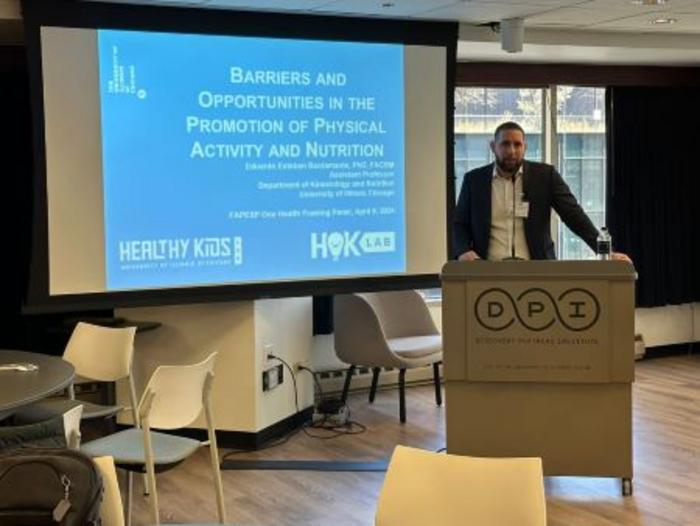Researchers test new behavioral health interventions
The concept of “One Health” – which emphasizes the relationship between human, animal, plant and environmental health – has been gaining ground in scientific discussions in recent years. Brazilian and North American researchers developing research using this approach presented their work on Tuesday (April 9th), in Chicago (United States), during FAPESP Week Illinois. Credit: Elton Alisson/Agência […]

The concept of “One Health” – which emphasizes the relationship between human, animal, plant and environmental health – has been gaining ground in scientific discussions in recent years. Brazilian and North American researchers developing research using this approach presented their work on Tuesday (April 9th), in Chicago (United States), during FAPESP Week Illinois.

Credit: Elton Alisson/Agência FAPESP
The concept of “One Health” – which emphasizes the relationship between human, animal, plant and environmental health – has been gaining ground in scientific discussions in recent years. Brazilian and North American researchers developing research using this approach presented their work on Tuesday (April 9th), in Chicago (United States), during FAPESP Week Illinois.
One of the panelists was Eduardo Esteban Bustamante, a professor at the University of Illinois in Chicago. He talked about behavioral interventions that have been tested to promote physical activity and healthy eating – practices that, according to the researcher, Americans still do not adhere to, despite the obvious benefits.
“The percentage of Americans meeting nutritional and physical activity recommendations is still very low. Among children aged six to 11, the percentage is 49% for boys and 35% for girls. But as they grow up, these rates get much worse, dropping to 7% and 4%, respectively, in the 16-19 age group, and stagnating at 3% and 2% from the age of 60 onwards,” Bustamante said. “When it comes to diet, the reality isn’t much better. Just over 10% of American adults over the age of 18 routinely eat fruits and vegetables,” the researcher said.
In an attempt to change this reality, behavioral health intervention programs have been developed and tested across the country. In the last few years alone, more than 3,000 evidence-based physical activity and nutrition interventions have been created in the United States. Of these, around 200 are available in public repositories for use by the public, according to a survey conducted by the researcher.
“These practices are made available on public websites. That way, people can get access to them and follow the instructions correctly to become more active and eat more fruits and vegetables, for example,” Bustamante said.
The problem, however, is that 90% of these scientifically tested physical activity intervention programs in the United States face barriers to dissemination and implementation that limit their potential impact on public health. One of the contributing factors is a lack of alignment with people’s expectations and with the places where they should be implemented, the researcher said.
“I’ve worked with a number of intervention programs, and one of the problems I’ve identified is that we didn’t think about the target audience before we started, and we saw that people weren’t engaged with them. We need to think about how to engage the target audience so that, from the beginning, our interventions fit in and are aligned with their goals,” he said.
“We also need to stop thinking of nutrition and physical activity as medicines that can only benefit health. They’re activities that take place in a context and we can use them to achieve the goals we want, whether they’re health-related or not,” said Esteban.
Based on this finding, the researcher and his collaborators have begun developing and testing new physical activity intervention programs in schools and communities.
For example, one project carried out in collaboration with the University of California Irvine has been using physical activity in schools as a way of learning mathematics. To this end, the basketball court at an educational institution was redesigned to teach children about fractions and decimals.
“The result is that the kids, in addition to getting all the health benefits of doing a physical activity, are learning math in a much more engaging way,” he said.
Another project, implemented in the Chicago Park District, one of the largest and oldest park districts in the United States, has been using sports and recreation to develop communication, emotional and conflict resolution skills in at-risk youths.
“The program works with young people who are in high school. We try to get them jobs during the summer so they can stay in the parks and work during that time, and we encourage them to develop behavioral skills through physical activity,” explained Bustamante.
Multifactorial causes
New approaches to behavioral health interventions are also vital to addressing the diabetes epidemic in the United States, said Marck Rosenblatt, dean of the University of Illinois College of Medicine.
“One in ten people in the United States has diabetes. The causes of this disease are multifactorial. It’s not just because people aren’t taking insulin and medications for hyperglycemia, but also because their diet is inadequate and they don’t exercise,” he said.
“It’ll take a multifaceted approach to address this problem, such as interventions in schools. We’re trying to work with local organizations to try to improve diet quality and encourage physical activity, while at the same time studying the molecular underpinnings of diabetes itself,” said Rosenblatt.
According to the researcher, the social determinants of health are an issue that the Chicago institution and health system have been working hard to understand and intervene in.
“It’s humbling to realize that only around 15% to 20% of a person’s health is related to the solutions we develop in our hospitals and clinics. People’s health is more related to their zip code, which correlates with a number of other factors, such as socioeconomic level, social and community context,” he said.
Environmental risks play a fundamental role in the emergence of degenerative diseases and cancer, emphasized Leandro Colli, professor at the Ribeirão Preto Medical School of the University of São Paulo (FMRP-USP), supported by FAPESP.
“We know that the cause of cancer is not only genetic. There are also very strong environmental factors. We can intervene in the genetic risk factors, but we also have to look at the environment,” he emphasized.
The researcher is working with collaborators on a project aimed at identifying mutational signatures in cancer patients – a concept that has emerged in recent years whereby it is possible to look at a cell mutation and try to recapitulate its origin and the agents that caused it.
“We’re starting a project in which we’re following a series of patients to try to better understand the risk factors for mutations that lead to cancer, such as tobacco, exposure to solar radiation and the burning of sugar cane in the Ribeirão Preto region,” said Colli.
More information about FAPESP Week Illinois can be found at: fapesp.br/week/2024/illinois.
What's Your Reaction?

































